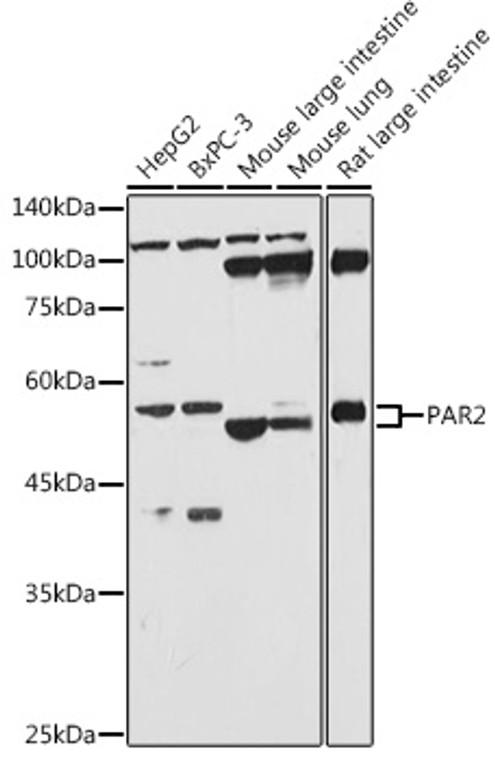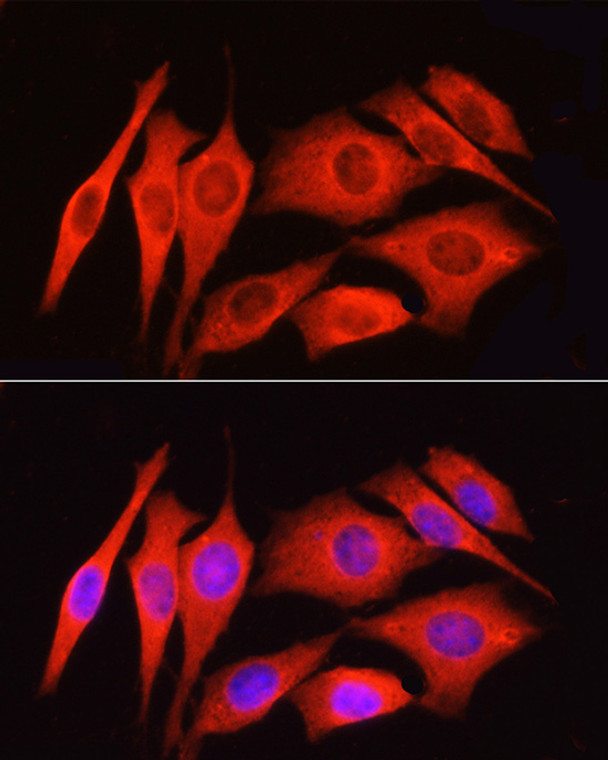| Tissue Specificity | Widely expressed in tissues with especially high levels in pancreas, liver, kidney, small intestine, and colon. Moderate expression is detected in many organs, but none in brain or skeletal muscle. Expressed in endothelial cells. |
| Post Translational Modifications | A proteolytic cleavage generates a new N-terminus that functions as a tethered ligand. Activating serine proteases include trypsin, mast cell tryptase, coagulation factors VII and Xa, myeloblastin/PRTN3 and membrane-type serine protease 1/ST14. Subsequent cleavage by serine proteases, including neutrophil elastase and cathepsin G, leads to receptor deactivation. At least in part, implicated proteases are also shown to activate the receptor.the glycosylation status of the receptor is thought to contribute to the difference. In addition to conventional trypsin-like proteases activated by other proteases and glycosidases derived from bacteria, fungi and insects. Activated by serine protease allergens such as dust mite Der p3 and Der p9 and mold Pen c13. Activated by P.gingivalis arginine-specific (trypsin-like) cysteine proteinases called gingipains. Activated by S.griseus exogenous chitinase. Activated by A.alternata aspartate protease.the cleavage generates non-conventional processed forms. Proteolytically cleaved by coagulation factor Xa (F10).cleavage results in activation of F2RL1-dependent signaling. N-glycosylated and sialylated. Multiple phosphorylated on serine and threonine residues in the cytoplasmic region upon receptor activation.required for receptor desensitization and recruitment of beta-arrestin. Monoubiquitinated by CBL at the plasma membrane and in early endosomes.not required for receptor endocytosis but for translocation to late endosomes or lysosomes. Deubiquitination involves STAMBP and USP8.required for lysosomal trafficking and receptor degradation. |
| Function | Receptor for trypsin and trypsin-like enzymes coupled to G proteins. Its function is mediated through the activation of several signaling pathways including phospholipase C (PLC), intracellular calcium, mitogen-activated protein kinase (MAPK), I-kappaB kinase/NF-kappaB and Rho. Can also be transactivated by cleaved F2R/PAR1. Involved in modulation of inflammatory responses and regulation of innate and adaptive immunity, and acts as a sensor for proteolytic enzymes generated during infection. Generally is promoting inflammation. Can signal synergistically with TLR4 and probably TLR2 in inflammatory responses and modulates TLR3 signaling. Has a protective role in establishing the endothelial barrier.the activity involves coagulation factor X. Regulates endothelial cell barrier integrity during neutrophil extravasation, probably following proteolytic cleavage by PRTN3. Proposed to have a bronchoprotective role in airway epithelium, but also shown to compromise the airway epithelial barrier by interrupting E-cadherin adhesion. Involved in the regulation of vascular tone.activation results in hypotension presumably mediated by vasodilation. Associates with a subset of G proteins alpha subunits such as GNAQ, GNA11, GNA14, GNA12 and GNA13, but probably not with G(o)-alpha, G(i) subunit alpha-1 and G(i) subunit alpha-2. However, can signal through G(i) subunit alpha. Believed to be a class B receptor which internalizes as a complex with arrestin and traffic with it to endosomal vesicles, presumably as desensitized receptor, for extended periods of time. Mediates inhibition of TNF-alpha stimulated JNK phosphorylation via coupling to GNAQ and GNA11.the function involves dissociation of RIPK1 and TRADD from TNFR1. Mediates phosphorylation of nuclear factor NF-kappa-B RELA subunit at 'Ser-536'.the function involves IKBKB and is predominantly independent of G proteins. Involved in cellular migration. Involved in cytoskeletal rearrangement and chemotaxis through beta-arrestin-promoted scaffolds.the function is independent of GNAQ and GNA11 and involves promotion of cofilin dephosphorylation and actin filament severing. Induces redistribution of COPS5 from the plasma membrane to the cytosol and activation of the JNK cascade is mediated by COPS5. Involved in the recruitment of leukocytes to the sites of inflammation and is the major PAR receptor capable of modulating eosinophil function such as pro-inflammatory cytokine secretion, superoxide production and degranulation. During inflammation promotes dendritic cell maturation, trafficking to the lymph nodes and subsequent T-cell activation. Involved in antimicrobial response of innate immune cells.activation enhances phagocytosis of Gram-positive and killing of Gram-negative bacteria. Acts synergistically with interferon-gamma in enhancing antiviral responses. Implicated in a number of acute and chronic inflammatory diseases such as of the joints, lungs, brain, gastrointestinal tract, periodontium, skin, and vascular systems, and in autoimmune disorders. Probably mediates activation of pro-inflammatory and pro-fibrotic responses in fibroblasts, triggered by coagulation factor Xa (F10). Mediates activation of barrier protective signaling responses in endothelial cells, triggered by coagulation factor Xa (F10). |
| Protein Name | Proteinase-Activated Receptor 2Par-2Coagulation Factor Ii Receptor-Like 1G-Protein Coupled Receptor 11Thrombin Receptor-Like 1 Cleaved Into - Proteinase-Activated Receptor 2 - Alternate Cleaved 1 - Proteinase-Activated Receptor 2 - Alternate Cleaved 2 |
| Database Links | Reactome: R-HSA-375276Reactome: R-HSA-416476 |
| Cellular Localisation | Cell MembraneMulti-Pass Membrane Protein |
| Alternative Antibody Names | Anti-Proteinase-Activated Receptor 2 antibodyAnti-Par-2 antibodyAnti-Coagulation Factor Ii Receptor-Like 1 antibodyAnti-G-Protein Coupled Receptor 11 antibodyAnti-Thrombin Receptor-Like 1 Cleaved Into - Proteinase-Activated Receptor 2 - Alternate Cleaved 1 - Proteinase-Activated Receptor 2 - Alternate Cleaved 2 antibodyAnti-F2RL1 antibodyAnti-GPR11 antibodyAnti-PAR2 antibody |









